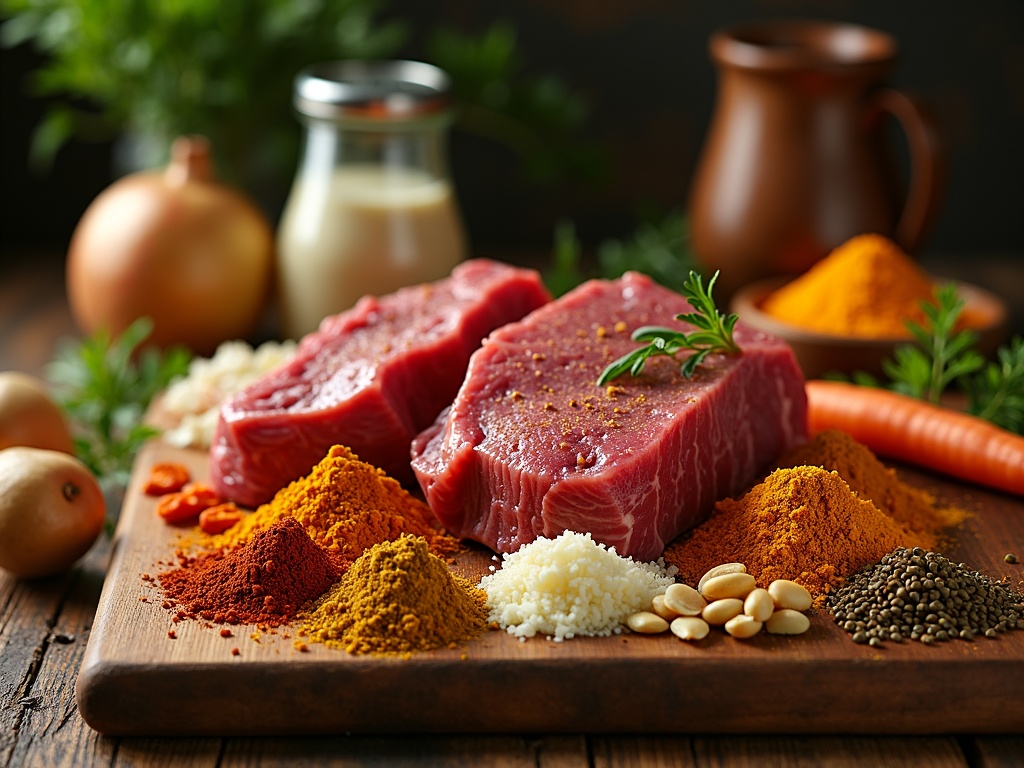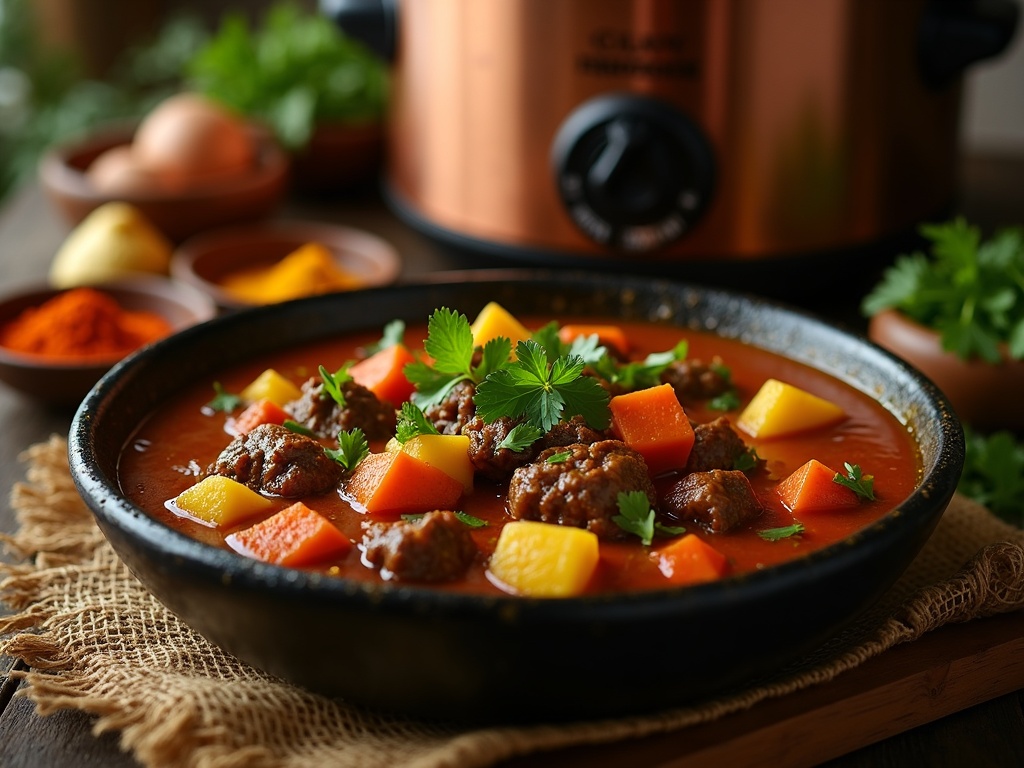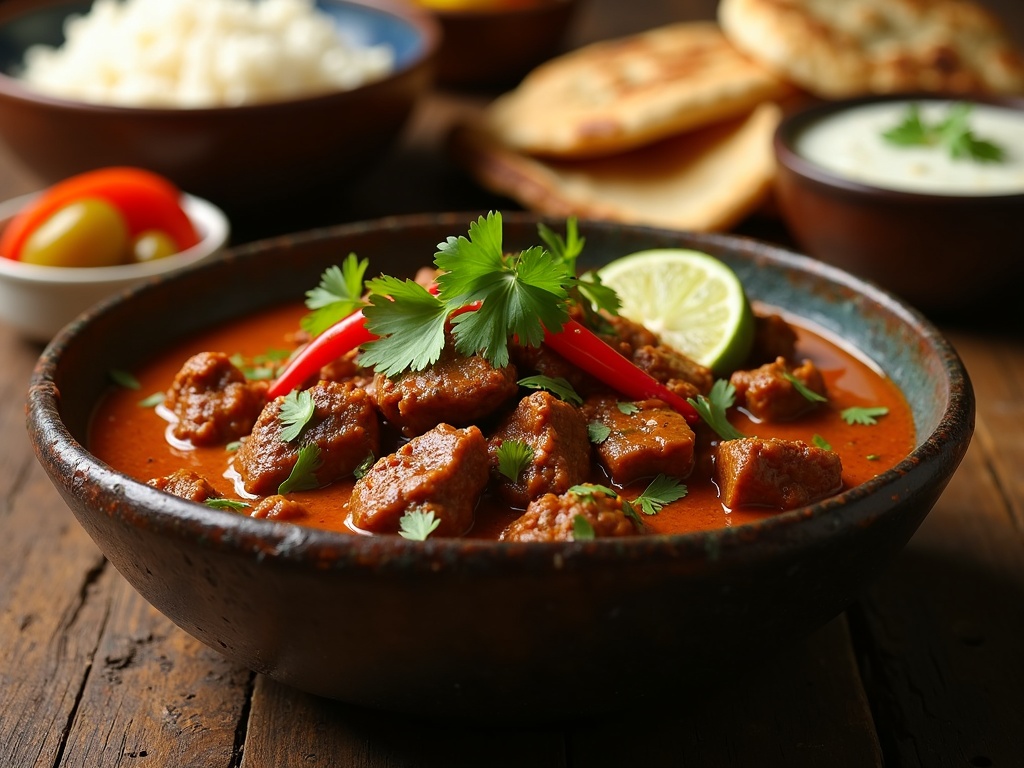This traditional beef curry recipe combines tender chunks of meat with aromatic spices in a rich, flavorful sauce that captivates food enthusiasts across cultures and continents. The dish offers endless variations – from Indian spice blends to coconut-infused Thai versions – while maintaining its soul-satisfying appeal as the ultimate comfort food.
Find In This Article
Key Takeaways
- Chuck or brisket cuts work best for curry, as these tougher, economical cuts break down beautifully during slow cooking for melt-in-your-mouth tenderness.
- The cooking method significantly impacts flavor development, with slow cooking (6-8 hours) creating the most tender meat, while pressure cooking offers a quicker alternative in just 45-60 minutes.
- Essential spices include curry powder, turmeric (used sparingly), and cumin (ideally toasted before adding), while aromatics like onions, garlic, and ginger form the flavor foundation.
- Beef curry provides 15-20 grams of protein per cup serving, along with vitamin B12, zinc, and additional nutrients from vegetables and spices like anti-inflammatory turmeric.
- Regional variations worth exploring include Kashmiri Rogan Josh with its distinctive red color, Thai Massaman curry with its coconut-peanut profile, and the luxurious Mughal-inspired Durbari curry.
The Ultimate Comfort Food: Why Beef Curry Recipe is a Global Sensation
I’ve found few dishes that warm the soul quite like a hearty beef curry simmered to perfection. The global curry powder market reached a staggering $3 billion in 2022, and it’s still growing—testament to curry’s universal appeal. This isn’t just a meal; it’s a cultural phenomenon that’s made its way from South Asian kitchens to dinner tables worldwide.
A Tale of Two Traditions: Indian vs Thai Curry
Indian and Thai curries represent two distinct but equally delicious approaches to this beloved dish. Indian beef curry typically features a rich gravy base loaded with warming spices like cumin, coriander, and garam masala. The sauce tends to be thicker, clinging beautifully to tender chunks of beef that have absorbed all those complex flavors.
Thai beef curry, on the other hand, often incorporates coconut milk for a silky, slightly sweet base that balances the heat of chili peppers. The flavor profile leans toward lemongrass, galangal, and kaffir lime leaves, creating a fresher, more aromatic experience. I’ve noticed that beef recipes with Asian influences tend to highlight these brighter notes.
Both styles have their passionate devotees, but what they share is the magical transformation of beef through slow cooking in spice-infused liquids. The result? Meat that practically melts in your mouth.
The Building Blocks of a Perfect Beef Curry Recipe
Creating an exceptional beef curry requires attention to several key components:
- Meat selection: Chuck or stewing beef works brilliantly as these tougher cuts break down during cooking, becoming tender while releasing flavor into the sauce.
- Spice foundation: Most curries begin with blooming whole or ground spices in hot oil to release their essential oils.
- Aromatics: Onions, garlic, and ginger form the flavor base in almost all curry traditions.
- Cooking method: Low and slow is the way to go—whether on stovetop, in the oven, or using a slow cooker.
- Balancing elements: Acidic components like tomatoes or tamarind paste cut through richness, while coconut milk or yogurt add creaminess.
What makes beef curry particularly special is its versatility. I can make a beef stew with paprika one day and pivot to a coconut-based curry the next, using similar techniques but achieving completely different flavor profiles.
The meat becomes incredibly tender through the long cooking process, absorbing the complex spices while also enriching the sauce. This harmonious relationship between meat and spice creates a dish that’s far more than the sum of its parts.
Beef curry also pairs beautifully with a variety of sides—from fluffy basmati rice to buttery naan bread or even curried sides for a complete feast. The sauce is perfect for sopping up with bread or mixing into rice, ensuring no flavor goes to waste.
What I find most remarkable about beef curry is how it manages to be both comforting and exciting. The familiar warmth of slow-cooked beef combined with the adventure of different spice combinations creates a dish that satisfies on multiple levels. It’s no wonder this dish has traveled so successfully across continents and cultures.
The beauty of beef curry lies in its adaptability—you can adjust the heat level, change up the vegetables, or switch between coconut milk and tomato bases depending on your mood or what’s in your pantry. This flexibility, combined with its rich, satisfying nature, explains why beef curry continues to grow in popularity around the world.
Essential Ingredients for the Perfect Beef Curry Recipe
Selecting the right ingredients makes all the difference when creating a mouth-watering beef curry dish at home. I’ve found that starting with quality meat and spices creates a foundation for flavors that truly shine.
Choosing the Best Beef
Chuck or brisket are my go-to cuts for curry. These tougher, more economical cuts break down beautifully during slow cooking, resulting in tender, flavorful meat. Chuck has excellent marbling that melts into the sauce, while brisket offers a slightly different texture that holds up well in spicy curries. Both cuts absorb spices wonderfully, making them perfect for this dish.
If you enjoy the savory flavor of beef in other dishes, you’ll appreciate how these cuts perform in curry. The slow cooking process transforms them into melt-in-your-mouth morsels that carry the curry flavors perfectly.
Spices and Base Ingredients
The heart of any curry lies in its spice blend. I always include:
- Curry powder or paste: The foundation that provides depth
- Onions: Caramelized for sweetness
- Garlic and ginger: Fresh is best for aromatic punch
- Coconut milk: Creates a rich, velvety sauce
- Turmeric: Use sparingly (1-3% of curry powder weight)
- Cumin: Always toast before adding for 50% more flavor
The proportions matter significantly. Turmeric should be used carefully—too much creates bitterness. Toasting cumin seeds before grinding dramatically enhances their nutty flavor profile, transforming the entire dish.
For vegetables, potatoes and carrots are classic additions that absorb the curry flavors while adding texture. They also help stretch the dish to feed more people without sacrificing quality.
I’ve found that adding coconut milk toward the end of cooking preserves its creamy texture. This technique creates a more balanced beef curry compared to heartier stews like goulash.
For those who enjoy experimenting with different protein options, the same spice blend works wonderfully in curried sausage recipes as well. The versatility of these core ingredients makes curry an approachable dish for home cooks at any skill level.
Remember that quality matters—fresh spices have significantly more flavor than those that have been sitting in your cabinet for years. When possible, grind whole spices just before cooking for maximum impact.

Master Chef’s Secrets to Cooking Beef Curry
Beef curry transforms from good to exceptional with the right cooking method. I’ve discovered that different techniques unlock unique flavor profiles and textures in this beloved dish, making it crucial to select the approach that suits your timeline and desired outcome.
The Magic of Slow Cooking
Slow cooking beef curry for 6-8 hours on low heat creates unparalleled tenderness that simply can’t be rushed. This patient approach breaks down tough connective tissues in beef cuts like chuck or brisket, resulting in melt-in-your-mouth meat that absorbs the rich curry spices completely.
For the best slow-cooked beef curry results, I recommend these essential steps:
- Brown the meat thoroughly before slow cooking to develop a deeper flavor foundation
- Layer your spices, adding some at the beginning and refreshing with more in the final hour
- Keep the lid on throughout cooking to maintain a consistent temperature
- Add vegetables like potatoes and carrots only in the final 1-2 hours to prevent them from disintegrating
This method works wonderfully for weekend cooking when you can set it and forget it while the magical transformation happens.
Quick But Effective Alternatives
When time doesn’t permit slow cooking, other techniques can still deliver excellent results. Pressure cooking beef curry reduces the cooking time to just 45-60 minutes while maintaining remarkable tenderness. The sealed environment forces flavor into the meat quickly, making it my go-to method for weeknight beef dinners with complex flavors.
Traditional simmering on the stovetop occupies the middle ground, requiring 2-3 hours of gentle bubbling. This method allows for easy monitoring and adjustment of spices and consistency throughout cooking. I’ve found that adding a splash of yogurt during simmering creates a silkier texture that balances the rich beef flavor with the warming spices.
For tougher cuts like shank or brisket, slow cooking reigns supreme, but tender cuts like sirloin work beautifully with faster methods. Each technique creates a slightly different flavor profile – slow cooking develops deeper, more integrated flavors, while pressure cooking maintains brighter spice notes similar to those found in curried dishes with other proteins.
The key with any method lies in allowing adequate time for the meat to absorb the complex curry flavors, transforming an ordinary dish into something truly memorable.

Nutritional Benefits You Need to Know
When I make beef curry at home, I’m not just creating a delicious meal—I’m also preparing something packed with essential nutrients. A typical 1 cup serving of beef curry contains approximately 250-350 calories, making it a reasonable option for a main course. What’s impressive is the protein content, with each cup delivering about 15-20 grams of protein, helping meet daily requirements for muscle maintenance and growth.
Protein and Micronutrient Profile
The star ingredient, lean beef, is a nutritional powerhouse on its own. A 3-ounce serving of lean beef provides an impressive 26 grams of protein, which supports numerous bodily functions including tissue repair and immune system health. I’ve found that using leaner cuts in my beef dishes provides all the flavor while keeping fat content more reasonable.
Beef is also one of the best sources of vitamin B12, which is crucial for nerve function and red blood cell formation. This vitamin isn’t found naturally in plant foods, making beef an important dietary source for many people. Additionally, the zinc content in beef helps support immune function and wound healing—benefits you won’t get from many other food sources.
The vegetables in curry add their own nutritional benefits. Depending on what I include, my beef recipes gain:
- Vitamin A from carrots and red bell peppers, supporting eye health
- Dietary fiber from onions, tomatoes, and other vegetables
- Antioxidants from garlic and ginger
- Additional vitamins and minerals from potatoes or sweet potatoes
For those watching their calorie intake, I can adjust my beef goulash recipe by increasing the vegetable-to-meat ratio while still maintaining a satisfying flavor profile. This approach lowers the calorie count while increasing fiber content, helping you feel fuller longer.
The spices used in curry aren’t just flavor enhancers—they bring health benefits too. Turmeric contains curcumin, known for its anti-inflammatory properties. Cinnamon may help regulate blood sugar, while cardamom supports digestive health. These aromatic additions make curried dishes not only tasty but also potentially beneficial for overall health.
If you’re concerned about sodium levels, making curry at home gives you complete control over salt content compared to restaurant versions. I often find that the complex flavors from spices allow me to reduce added salt without sacrificing taste.
For a balanced meal, I pair beef curry with brown rice instead of white, adding extra fiber and nutrients while creating a complete protein dish. The combination provides sustained energy release, making it perfect for active individuals or those needing stable blood sugar levels throughout the day.
How to Serve and Store Your Curry
Once your delicious beef curry is ready, proper serving and storage will enhance your dining experience and preserve leftovers efficiently. I’ve perfected these methods through years of curry-making, and they’ll help you enjoy every last bite.
Perfect Serving Portions and Pairings
For ideal portions, I recommend serving 1 cup of curry with either 1 cup of steamed rice or 2 pieces of bread like naan or roti. This balanced ratio ensures you taste all the complex flavors without overwhelming your palate.
Your curry deserves complementary side dishes that enhance its taste profile. Consider these accompaniments:
- A cooling raita made with yogurt, cucumber, and mint to balance the spice
- Tangy pickles or chutneys that contrast with the savory curry
- A simple salad with lemon dressing for freshness
- Sliced onions mixed with lemon juice and a sprinkle of salt
These sides work equally well with other beef dishes like beef teriyaki or beef goulash, adding variety to your meal rotation.
Storage and Reheating Tips
Curry often tastes even better the next day after the spices have had time to meld. To properly store leftovers:
Store in an airtight container in the refrigerator for 3-4 days. The flavors will actually deepen during this time, making for an even more flavorful meal later.
For longer storage, freeze portions in freezer-safe containers for up to 3 months. I find dividing into single-serving portions makes for convenient future meals, similar to how I store curried sausages for quick weeknight dinners.
When reheating, the slow stovetop method yields the best results. Add a splash of water to prevent drying, then heat on low-medium, stirring occasionally. This gentle approach preserves the texture of the beef and prevents spices from becoming bitter.
Microwaving works in a pinch, but cover the dish and use medium power with short intervals, stirring between each to distribute heat evenly.
With these serving suggestions and storage practices, you’ll enjoy your beef curry to its fullest potential both fresh and as leftovers.
Global Curry Variations to Try
The rich world of beef curry spans continents, with each region adding their unique touch to this hearty dish. I’ve explored many variations in my culinary journey and found that regional specialties offer fascinating flavor profiles that can transform your dinner table.
Regional Specialties Worth Mastering
Kashmiri Rogan Josh stands out with its distinctive red color and aromatic spice blend. This curry traditionally uses yogurt instead of cream, creating a tangy depth while tenderizing the beef. The signature Kashmiri chili provides both color and moderate heat, complemented by warming spices like cinnamon, cardamom, and cloves.
Thai Massaman curry offers a completely different experience with its unique fusion of Thai and Persian influences. Unlike the tomato-based beef casseroles common in Western cooking, Massaman incorporates coconut milk with cardamom, cinnamon, and star anise. The addition of potatoes and peanuts creates a hearty texture that balances beautifully with tender beef chunks.
For something truly regal, Mughal-inspired Durbari curry delivers layers of flavor through slow cooking and complex spice combinations. The hallmark of this curry is its rich, velvety gravy enhanced with cream, nuts, and dried fruits – a nod to the lavish palace cuisine of ancient Indian rulers.
I’ve found that adapting these regional recipes allows for wonderful creativity in the kitchen. For example, the spice blend from Rogan Josh works beautifully in a beef goulash, while Massaman curry spices can transform a basic beef teriyaki into something extraordinary.
If you’re looking to switch things up beyond beef, these curry styles adapt wonderfully to other proteins. Goat meat, popular throughout South Asia and the Caribbean, has a slightly gamier flavor that stands up brilliantly to bold curry spices. The meat becomes incredibly tender when slow-cooked, absorbing all the complex flavors.
Chicken offers a lighter alternative while still carrying the curry flavors effectively. It cooks faster than beef, making it perfect for weeknight dinners when you’re craving curry but short on time. The mild flavor of chicken allows the spice blend to take center stage – especially effective in the aromatic Massaman style.
For those seeking plant-based options, young jackfruit provides an uncanny meat-like texture that shreds similar to slow-cooked beef. Its mild flavor absorbs curry spices beautifully, making it an excellent canvas for your favorite curry sauce. Mushrooms – particularly king oyster or portobello varieties – offer a meaty umami quality that satisfies in curries. Their natural savory notes complement the spices while providing a fraction of the calories found in meat-based versions.
I’ve also had great success using hearty vegetables like cauliflower, eggplant, and chickpeas in place of meat. These work particularly well in preparations like curried sausages where the sauce carries most of the flavor.
The beauty of curry lies in its adaptability. Starting with authentic regional recipes gives you a foundation of traditional flavor combinations, but don’t be afraid to customize according to your taste preferences and what’s available in your pantry. Whether you’re exploring the fiery depths of a Kashmiri Rogan Josh or the complex sweetness of a Thai Massaman, curry’s global variations offer endless possibilities for delicious discoveries.
Sources:
Global Spices Market Report
Nutritional Facts for Beef Curry from USDA FoodData Central
Various Cooking Techniques: The Science of Cooking by Harold McGee
Serving Portion Guidelines from the American Dietetic Association
Curry Variations from Indian Cuisine: The Complete Book of Indian Cooking by Ranjit R. Sethi

